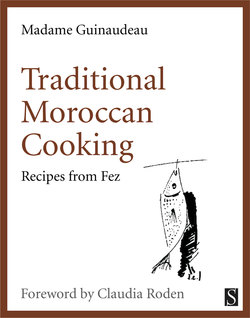Traditional Moroccan Cooking

Реклама. ООО «ЛитРес», ИНН: 7719571260.
Оглавление
Madame Guinaudeau. Traditional Moroccan Cooking
FOREWORD
PREFACE
AUTHOR’S FOREWORD
TABLE MANNERS AND CUSTOMS
THE KITCHEN
UTENSILS FOR COOKING AND SERVING
POTTERY
SPICES
RAS EL HANOUT
OLIVES
LEMONS PRESERVED IN SALT
BREAD
SOUPS
BISTILLA
BROCHETTES
CHOUA
KEFTA
RGHAIF
TRID
SNAILS
COUSCOUS
CHARIYA
SALADS
EGGS
LBEN
BUTTER
FISH
TAGINES
CHICKEN
STUFFED CHICKEN
MUTTON
OTHER MEATS
FRIED, BROWNED AND MARINATED MEATS
QAMAMA TAGINES
TFAIA TAGINE
KDRAS
SPRING TAGINES
SUMMER TAGINES
FRUIT TAGINES
TAGINES WITH FRUIT AND HONEY
VEGETABLES
CAKES AND PASTRIES
EL MAJOUN
FRUIT
DRINKS
THE ART OF MAKING AND DRINKING TEA
AROMATICS
THE DISTILLATION OF ORANGE BLOSSOM AND ROSE PETALS
NEZAHA
RESTAURANTS
CAFÉS
THE MARKETS AND FOOD SHOPS OF FEZ
MECHOUI
THE CORPORATION OF COOKS
PUBLISHER’S NOTE
INDEX
Отрывок из книги
When years ago I travelled to research Morocco’s cooking, Madame Guinaudeau was mentioned to me by everybody I met and I talked to several people who boasted that they had given her recipes. They all spoke of her with affection and respect. Today, although a number of books have appeared on the subject of their country’s cuisine, a younger generation of Moroccans has the greatest respect for Madame Guinaudeau’s Fès Vu par sa Cuisine, first published in 1958 and translated here as Traditional Moroccan Cooking: Recipes from Fez. That the most exclusive restaurant in Fez has been called Fés Vu par sa Cuisine is an indication of the high regard in which the book is held. Moroccans are immensely proud of their cuisine and rightly regard it as one of the best in the world, so for a foreign author to be so highly esteemed by them is no small accolade.
By all accounts the book was the first on Moroccan cooking since an anonymous compilation of Maghrebi and Andalusian recipes appeared in Arabic in Spain in the twelfth century. (As her book went off to press Madame Guinaudeau added a note that she had thought she was the first person to write about Moroccan food, but that after writing it she heard that a work by John, 4th Marquis of Bute, entitled Moorish Recipes was published in Edinburgh in 1955.) That is merit in itself, but the book is also remarkable in many other ways. There is in Madame Guinaudeau’s writing a truth and authenticity which is rarely found in cookery books. Every recipe, every description, every detail of people’s lives which she gives is the result of her own observation, which makes her book completely original and absolutely unique; there is passion and enthusiasm which comes through in every page.
.....
It is not seemly to offer water, which distends the stomach, but if necessary one can ask to quench one’s thirst.
The meat dishes finished, the broken bones are rapidly swept away, the table cleared.
.....